

GradeCam - Grading With A Camera. Articulate Storyline Pearls. Learning-styles.jpg. E-Learning Project Management. Google. 7 Micro-eLearning Techniques to Improve Performance. In this article, I will offer you an in-depth look at how you can integrate Micro-eLearning techniques into your eLearning course, in order to improve performance and provide your students or employees with the most beneficial eLearning course design.

There are a variety of benefits associated with Micro-learning, particularly in eLearning environments. In essence, micro-eLearning offers students and employees the opportunity to more easily absorb and retain the information that is being offered, by making lessons and course activities more manageable and “digestible”. Micro-eLearning is often referred to as “bite sized” education, because it breaks the educational process down into lessons that typically last no longer than a few minutes, and enable them to collect and recall course materials more efficiently and effectively.
Micro-eLearning Technique #1: Micro-games online It's a proven fact that people learn more if they are engaged with the subject. References:
Flipped classroom. Crystal Kirch. What do you do when you’re presenting a lesson to 40 students and feel like you’re just not reaching them?
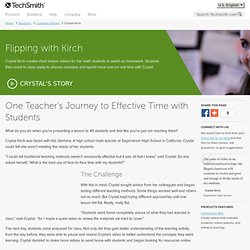
Crystal Kirch was faced with this dilemma. A high school math teacher at Segerstrom High School in California, Crystal could tell she wasn’t meeting the needs of her students. “I could tell traditional teaching methods weren’t necessarily effective but it was all that I knew,” said Crystal. So she asked herself, “What is the best use of face-to-face time with my students?” The Challenge With this in mind, Crystal sought advice from her colleagues and began testing different teaching methods.
“Students went home completely unsure of what they had learned in class,” said Crystal. The next day, students came prepared for class. The Solution Within a few weeks, Crystal was well on her way to flipping her classroom. Crystal continued to flip her class, spending her planning hours converting old lesson plans into 5 – 10 minute videos for students. The Results.
Tools. Future e-Learning. Social Learning. Changesetter - Change-technology - theory, psychology and praxis. Top 5 eLearning Skills for 2011. Posted by Eric Matas in eLearning Careers.
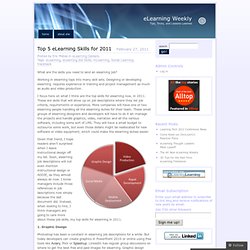
Tags: eLearning, eLearning Job Skills, mLearning, Social Learning trackback What are the skills you need to land an elearning job? Top 10 Instructional Designer Skills. All jobs require a certain set of talents and skills, whether natural or acquired.
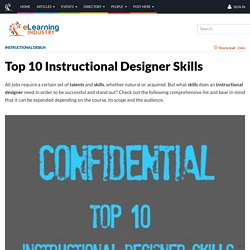
But what skills does an instructional designer need in order to be successful and stand out? Check out the following comprehensive list and bear in mind that it can be expanded depending on the course, its scope and the audience. Possess interdisciplinary knowledge, cross-cultural competency, as well as commitment and passion for learning and technology.Have a background in education, a critical attitude, and clear learning objectives.Conduct thorough research, boast good analytical skills and the ability to synthesize information from various sources.Effectively communicate both visually and verbally, be a good listener and create measurable objectives, based on the audience’s needs.
Instructional designer skills set overview. The Learning Landscape Model by Dr. Will Thalheimer. Four Phases of Learning. Learningtheories-full.jpg (JPEG Image, 1614 × 1145 pixels) - Scaled (57%) What did Einstein know about Knowledge Management? Quite a lot, it appears!
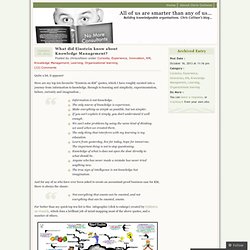
Here are my top ten favourite “Einstein on KM” quotes, which I have roughly curated into a journey from information to knowledge, through to learning and simplicity, experimentation, failure, curiosity and imagination… Information is not knowledge.The only source of knowledge is experience.Make everything as simple as possible, but not simpler.If you can’t explain it simply, you don’t understand it well enough.We can’t solve problems by using the same kind of thinking we used when we created them.The only thing that interferes with my learning is my education.Learn from yesterday, live for today, hope for tomorrow.
The important thing is not to stop questioning.Knowledge of what is does not open the door directly to what should be.Anyone who has never made a mistake has never tried anything new.The true sign of intelligence is not knowledge but imagination. The Myth Of Learning Styles. The Lean Learning Cycle. The Lean Learning Cycle The Deming Cycle & Learning Lean Manufacturing is much more than a set of tools.

Lean is a way of thinking that can and should result in a culture change. Part of the culture change is becoming a learning organization. Since Lean Practitioners embrace Deming’s Plan – Do – Check – Act cycle (PDCA), it makes sense to utilize PDCA as part of the learning process. As a leader, you need to create opportunities for your team to learn and to reflect on their new knowledge. Learn – You and your team need to be learning daily. Please leave a comment below if you liked this article. Like this: Like Loading... About Christian Paulsen Christian Paulsen is an Executive Consultant with 20 years of Lean Manufacturing. The Important Concept of eLearning. "By luck, I stumbled upon your site, and of course I wanted to try it out.

I went on to deposit $500 on OneTwoTrade, then opened 5 positions and won 4. Took out the $500 and still have the profit of $288 to trade with. This is a great system you got there Sir, I definitely owe you one. " Shelly Green - New York "I began with $200 on OneTwoTrade and I went down to $100 the first day. Everything elearning. Instructional Design in Elearning George Siemens September 30, 2002.
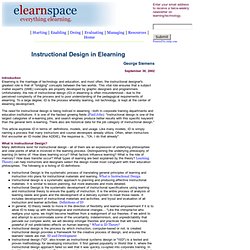
Infographic - implementing e-learning for training organisations. A business case is key to sustaining e-learning (Callan and Bowman, 2010), especially as a large barrier to implementing e-learning is financial (FLAG, 2013).
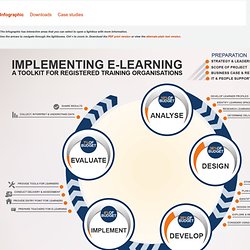
For our eight projects, the allocation of resources and development of a strong business case was an early indicator of success. The return of investment (ROI) varied across projects. Some saw a direct savings in printing costs, teaching hours, more efficient administration or communication. For others, there wasn't an easily quantifiable ROI, as the benefits were long term, like increased engagement, increased enrolments, increased retention and internal capability building. Innovative use of new technology can result from financial drivers.
The Tasmanian project is an example of technology enabled delivery that would have been cost prohibitive using other methods. Developing a business case can be approached from a user-based design method. Often teams aren't sure how to allocate funding or resources across a project. Exposing 5 Popular e-Learning Myths. 5 E-Learning Myths ExposedImage courtesy of imagerymajestic / FreeDigitalPhotos.net Tuesday, 18 February 2014 14:23 People’s opinions on the effectiveness of e-learning vary based on their own experiences.

Determining what is true and what is myth can be challenging. Based on the 20 years of experience Interactive Services has in designing and developing custom learning solutions for compliance, sales, manufacturing and technology, our company has addressed a number of popular myths about e-learning. If you build it, they will comeThis mantra can be the downfall for many companies.
Scenario Based e-Learning.